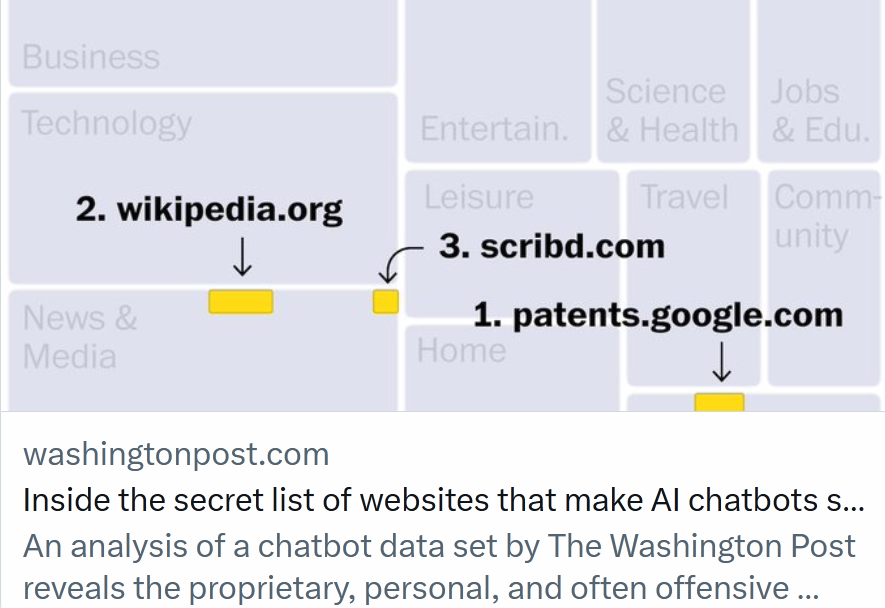Navigating DOM Visibility and License Clarity
Navigating DOM Visibility and License Clarity
Creative Commons (CC) provides an important service by offering machine-readable copyright licenses, which allows search engines and other applications to easily identify and understand the terms of use for a given work.
Machine readable licensing is super relevant and has reached a wider audience with people becoming aware of how the internet is scraped for data—in the current case for training LLM (large language models) for ChatGPT and other Chat Ais.
They use a large trough of data, mostly scraped from the internet. The Washington Post investigated that black box with researchers at the Allen Institute for AI the data and found many copyright snippets in the dataset of publicly available C4 data set.

However, when using Webflow CMS to generate a CC license for blog posts, there is a potential issue related to the Document Object Model (DOM) and the visibility of multiple license options.
Let’s take a look at the issue that web developers and content creators might face when using Creative Commons licenses within Webflow CMS, and propose a possible solution to ensure clarity for both human readers and machine-based applications.
The Challenge
When integrating CC licenses into a publication process in Webflow CMS, authors can choose from multiple license options. Each option generates a unique CC text snippet, which is then displayed under the blog post. The issue arises because all of the text snippets, regardless of the license chosen, become part of the DOM. Because the chosen license option is set to visible, while the others remain hidden.
Creative Commons (CC)
With Creative Commons (CC) creators get a range of standardized copyright licenses to legally share their work. These licenses grant specific permissions to users, such as the ability to copy, distribute, or modify the content while still attributing the original creator. CC licenses help to promote the sharing of knowledge and creativity in the digital age, making it easier for people to find, use, and build upon/remix the work of others.
The problem stems from the HTML snippet provided by Creative Commons, which employs a machine-readable format for licenses. When machines or search engine robots read the DOM, they may encounter conflicting licensing options if they do not consider the non-visible states. This confusion can lead to misinterpretation of the intended license, particularly since Creative Commons licenses are non-revocable.
Document Object Model (DOM)
The Document Object Model (DOM) represents the structure of a document as a tree of objects, where each object corresponds to a part of the document, such as an element, an attribute, or a piece of text. The DOM allows programmers to manipulate the content and structure of a document using scripting languages like JavaScript. In the context of this article, the DOM is relevant because it's where the Creative Commons license text snippets reside, potentially leading to confusion for search engines and other applications that rely on machine-readable licensing information.
Possible Solution
The solution cannot be to use a non-machine-readable CC license sign or signifier to help prevent misinterpretation and ensure clear communication of the intended license. This is more of a marketing signal of "I belong the creative commons tribe", than it is to make it a useable feature for confident licensing as it is promised by machine readable tags.
To avoid potential conflicts and ensure clear communication of the intended license, one solution could be to make the utilization of a “visible” sign or signifier a part of the -machine-readable Creative Commons license html tags. By doing so, machine readers can easily understand the chosen license while avoiding potential misinterpretation.
Conclusion
While Creative Commons provides a valuable service with its machine-readable licensing options, it is crucial to ensure that the implementation within Content Management systems and its display in the DOM avoids confusion for both licensees, those giving an irrevocable license, and machines.
How can authors maintain the integrity of their chosen licenses and promote clear communication of their work's terms of use? This contradicts making it easy for machines to assist one in your daily live by making it more difficult for them to “behave correctly”. While the CC machine readability is a great step I do not feel certain implementing it in the correct way in order for me to be of service the authors.
When I provide an easy option for authors to choose a license beyond the total copyright with all rights reserved, I want to be certain that it is clear to everyone which license is provided and what it allows.
The workflow of letting authors license their work from the Webflow CMS fails at that. Eventually I opted to not implement any licensing at this point, making it harder for creators to license their work, get attribution, and harder for people to share their work and give attribution.
I would love for you sharing your own experiences and solutions with Creative Commons licensing and Webflow CMS – here, or on Twitter.
References
Comments archived (
Date
)
-none-




